A powerful show of anger and opposition to the military coup launched at the beginning of February was evident on the streets of cities across Myanmar last Monday (February 22nd), as a general strike paralysed the country, from Myitkyina in the north, to Bhamo near the Chinese border, to Pyinmana in the centre.
The protest rallies were among the largest since the coup began four weeks ago, and took place in many towns across the country. Factory workers downed tools and turned up at the rallies with their trade union banners, government workers were out in big numbers, students came out, and shops closed as part of a general strike against the coup, despite the junta threatening the protestors that their actions could cost them their lives.
Courage of the masses against brutal clampdown
This came after huge crowds attended the funeral of Mya Thwate Thwate Khaing: the young woman who died after being shot in the head on 9 February. Two other protesters had been killed the previous day by police when they opened fire on protestors in Mandalay. Meanwhile, the number of people who have been arrested has continued to rise, among them over 80 doctors, despite the ongoing coronavirus pandemic.
After the general strike, mass protests continued unabated throughout last week. But over the weekend, the military regime massively stepped up its clampdown on the protestors, killing at least 18 in several cities across the country. This marks a qualitative change in the approach of the regime, which is finding itself increasingly isolated and with hardly any base of support in society.
The police fired live ammunition into the crowds, backed up by the army, leading to the bloodiest day yet since protests broke out after the military takeover. The reason why the state forces resorted to the use of live ammunition is that stun grenades, tear gas and shots into the air were failing to break up the crowds.
There is widespread concern that the military could respond as they did back in 1988, when they killed thousands on the streets. What is amazing, however, is the sheer resilience of the masses in the face of such danger to their lives. The masses hate this regime and are determined to do everything they can to bring it down. Today the protests continued, and three protesters were seriously injured when live rounds were fired at protesters in northwestern Myanmar. Today Yangon was described as a battlezone with continuing protests and fighting with the security forces. [See here for videos]
Defiance has not only been expressed in repeated street protests, but also in strikes by transport workers, government workers, municipal workers, and workers from the judiciary, the education and health sectors, as well as the media.
It is this defiant mood of the masses that has pushed the military junta into the corner, and the military chiefs now know that either they must crush the movement or start to retreat. But they also understand that to retreat even one step would be seen by the masses as weakness, and they would be encouraged to push back with even greater vigour.
According to the state-run MRTV television, close to 500 people were arrested on Saturday alone, as part of the nationwide police crackdown. The military chiefs are clearly hoping to tire the movement out, counting on the lack of a fighting leadership, while combining this with heavy repression to instil fear among the population.
The latest news – according to The Mirror, a state-owned newspaper – is that the military have now decreed that trade unions are illegal. The military understands that the backbone of the movement has been the organised working class, and in particular sectors such as the garment workers, the healthcare workers, and workers in the ministries, transport and teaching. The military are intent on removing this threat, but the problem is that a new generation of workers has emerged over the past decade that has learnt to appreciate the right to strike and to organise. They have employed these rights on a grand scale in the battle against the coup.
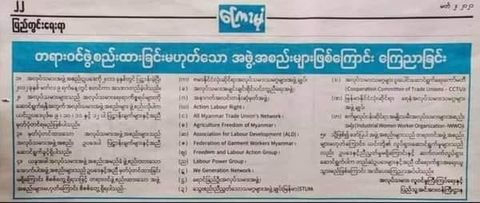 The Mirror announcing the banning of trade unions
The Mirror announcing the banning of trade unions
The workers of Myanmar, together with the youth, have shown tremendous courage in the face of a brutal military apparatus. It is one month since the coup and they are still coming out in huge numbers onto the streets to protest. Last Monday’s general strike was a powerful show of strength and revealed what enormous power the workers of Myanmar have. In the picture below we see the massive rally in the city of Mandalay during the general strike.
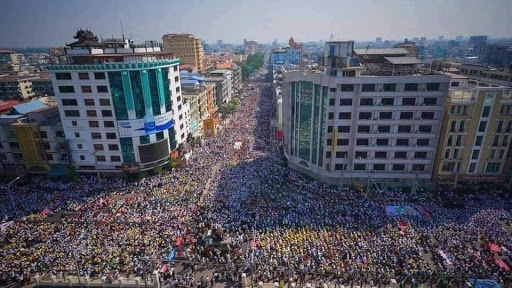 From the Twitter account of Civil Disobedience Movement in Myanmar
From the Twitter account of Civil Disobedience Movement in Myanmar
Huge people’s assemblies were called during the strike movement. Below, we have pictures of the assembly in Monywa: a major centre for trade and commerce, the largest city in Sagaing Region, to the north-west of Mandalay, and one of the largest industrial areas in Myanmar.
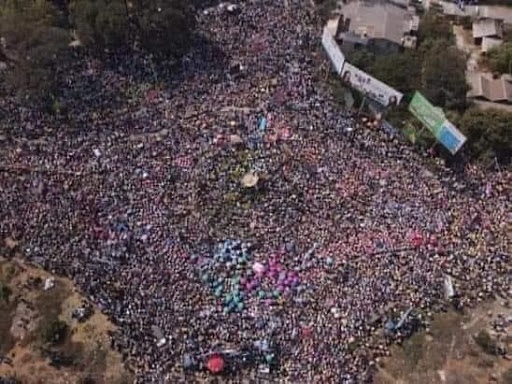
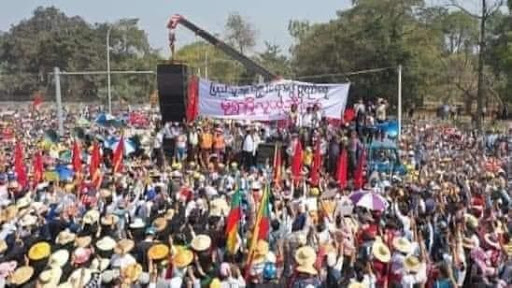
Several hundred thousand people attended the assembly in Monywa, where the “public administration committee” was formed with the support of the people. The following day, when the police tried to crack down on the Monywa people, the people surrounded them, and set up barricades to block the march of the Supplementary 33rd Division, which was being sent to brutally crackdown on the protestors.
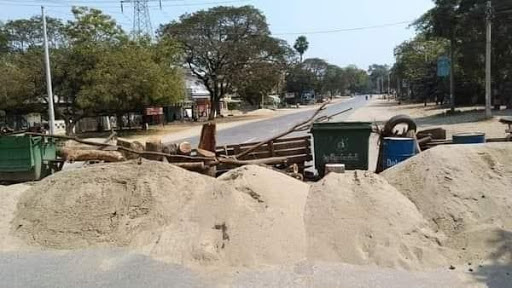
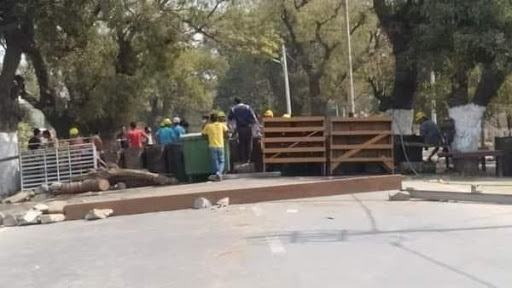
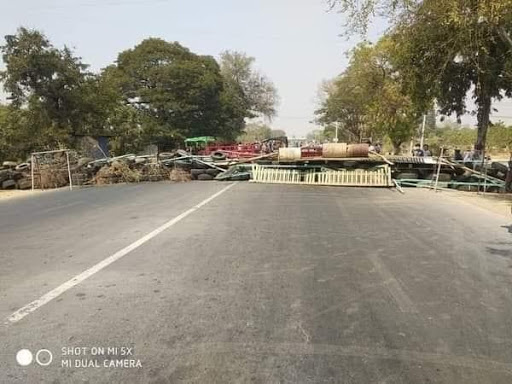
This forced the regime to send in thousands of soldiers, who in turn surrounded the people. The police also mobilised lumpen elements to beat the people, and even the CEO of the Monywa Gazette, a local journal. These were the scenes after the military arrived, using live ammunition to clear the crowd:
The Myanmar masses have been fighting back with all their might. They have organised strike wave after strike wave, culminating in last Monday’s powerful general strike. They have organised sit-ins at work, they have attempted to organise some kind of self-defence in some areas. They have created groups of “night watchmen” in the neighbourhoods in an attempt to stop the nightly raids by security forces looking for activists in their homes. Tragically, there have been cases of some of these being killed, as they are unarmed.
The minorities have joined the movement against the military, for despite their misgivings about Aung San Suu Kyi (aka ASSK) and the NLD, they are fully conscious of the fact that the military are not friends of the minority peoples of Myanmar. The peasants are against the military, the shopkeepers have participated in the movement, the industrial workers and the government workers, the youth – all these layers have been involved.
Lack of revolutionary leadership
What we have witnessed in the past month in Myanmar is a pre-revolutionary situation, which could very easily become revolutionary, if only the masses had a leadership up to the task. But the masses are “lions being led by donkeys”, as the saying goes. The masses display immense courage, but who leads them?
The political leadership is still in the hands of the NLD (National League for Democracy) under the figurehead of ASSK. And what do these “leaders” preach to the masses? “Peaceful protest” and “non-violence”, while the military are shooting people on the streets, rounding them up at night in their houses, arresting hundreds, and beating many more. The people do what they can to defend themselves with barricades and unarmed self-defence groups.
There is no limit to how far bourgeois liberals will go in their attempts to hold the mass movement within certain limits. Even when they themselves are arrested and imprisoned, they appeal to the masses not to go too far, to protest “peacefully” and to adhere to “non-violent” methods of struggle. When the NLD were in office, we heard no such appeals to non-violence when the military was brutally crushing the minorities.
Oh no, when thousands of Rohingya were being killed and their villages burned, the kind and gentle ASSK defended Myanmar’s military against genocide allegations back in December 2019 in her speech to the International Court of Justice (ICJ). (See Transcript: Aung San Suu Kyi’s speech at the ICJ in full).
Thus, when mass killings, rape, the burning of people’s houses and the expulsion of thousands of people was being carried out, there was a white-washing of the violence of the military. But when it comes to the legitimate right of the people to defend themselves in the face of brutal violence of the bourgeois state, then these liberals play a very different tune.
The role of bourgeois liberals such as ASSK is to lead the lamb to the slaughter, whispering sweet words into the ears of the lamb, reassuring it that all is well: as long as the lamb doesn’t put up resistance, no harm will come to it. Meanwhile, the butcher prepares his knife to cut the defenceless lamb’s throat!
Lenin on the role of the liberals
It is tragic today that there are parties who claim to be “Communist” who hang on to the coattails of liberals like ASSK and preach unity with these people. It is worth reminding these “Communists” what Lenin had to say on such matters. In 1914 he explained that:
“In all capitalist Countries throughout the world, the bourgeoisie resorts to two methods in its struggle against the working-class movement and the workers’ parties. One method is that of violence, persecution, bans, and suppression. In its fundamentals, this is a feudal, medieval method. Everywhere there are sections and groups of the bourgeoisie—smaller in the advanced countries and larger in the backward ones—which prefer these methods, and in certain, highly critical moments in the workers’ struggle against wage-slavery, the entire bourgeoisie is agreed on the employment of such methods. Historical examples of such moments are provided by Chartism in England, and 1849 and 1871 in France.
“The other method the bourgeoisie employs against the movement is that of dividing the workers, disrupting their ranks, bribing individual representatives or certain groups of the proletariat with the object of winning them over to its side. These are not feudal but purely bourgeois and modern methods, in keeping with the developed and civilised customs of capitalism, with the democratic system.
“For the democratic system is a feature of bourgeois society, the most pure and perfect bourgeois feature, in which the utmost freedom, scope and clarity of the class struggle are combined with the utmost cunning, with ruses and subterfuges aimed at spreading the ‘ideological’ influence of the bourgeoisie among the wage-slaves with the object of diverting them from their struggle against wage-slavery.” (V. I. Lenin, The Bourgeois Intelligentsia’s Methods of Struggle Against the Workers, June 1914)
Earlier, in 1908, the same Lenin had warned:
“…these specious arguments, arrayed in ostensibly Marxist garb, concealed a policy of weakening the class independence of the proletariat and subordinating it (in effect) to the liberal bourgeoisie. (...)
“We must distinguish between the programmes of the bourgeois parties, between the banquet and parliamentary speeches of the liberal careerists and their actual participation in the real struggle of the people. Bourgeois politicians, one and all, in all parliamentary countries, have always paid lip-service to democracy while betraying it.” (V. I. Lenin, Deception of the People by the Liberals, 1908)
Why do the bourgeois liberals behave in this manner? It is because they cannot conceive of a movement that goes beyond the limits of the capitalist system. They defend private property of the means of production. They may have some minor differences with the military chiefs on who should own this property or how much of it should stay with the military oligarchs and how much should be sold off to foreign multinational corporations, but that there should be an “owner” remains their religion.
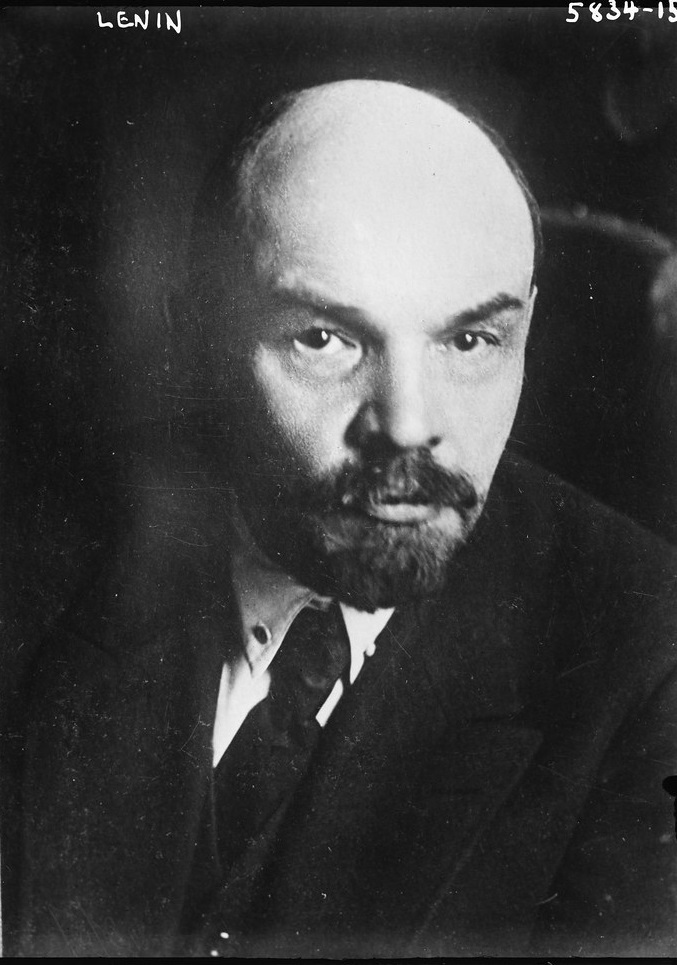 As Lenin warned, the bourgeois liberals will line up with the forces of the capitalist status quo in the last analysis / Image: public domain
As Lenin warned, the bourgeois liberals will line up with the forces of the capitalist status quo in the last analysis / Image: public domain
Therefore, if your aim is to preserve a society where there are employers and employed, exploiters and exploited, owners of the means of production and those who work those same means of production, and if you see yourself as belonging to the camp of the owners, you don’t want the workers at the bottom getting any strange ideas about who should own the factories and how they should be run.
The liberal bourgeois will therefore shout about democracy and human rights so long as this doesn’t threaten to unleash a mass movement that could go beyond the confines of the capitalist system. It is because of this that the workers and youth of Myanmar cannot place their hopes for a better life in the hands of parties like the NLD.
This also means they cannot count on these people to defend them against the brutal clampdown presently taking place. The workers, the peasants, the youth must take their destinies into their own hands.
The youth in particular are very angry, as they see fellow protestors being shot in cold blood on the streets of cities across the country. They know from previous experiences, in particular the events of 1988, how brutal the military can be, and they want to fight back and remove them from power. The question is how is this to be done.
The danger in a situation like this is that the most advanced elements draw the wrong conclusions. The working class is the only class that can remove the military once and for all. For removing the military does not mean just sending them back to barracks until the next time they feel their interests are threatened. No, to remove the military you must remove their economic power as well. The demand for the expropriation of all the companies that have been appropriated by the military over the past decades is a central part of any serious struggle to put an end to the power of these oligarchs.
Such a demand cannot be carried out by any bands of heroes who challenge the military. It can only be carried out by a working class that is conscious of its role in society, which has a party of its own with a clear understanding of the tasks at hand. In the past, the Communist Party could have played such a role, and the experience of the Burmese communists has some lessons for today’s movement.
The Communist Party played an important role in the struggle for independence at the end of the Second World War, but they left the leading role in the hands of the upcoming national bourgeoisie. Thus, they entered a popular front with them. However, once formal independence had been achieved, the Burmese bourgeois no longer required the services of the Communist leaders, and by 1953 they had banned them. That is when the Communists turned to rural guerrillaism, abandoning the cities, and attempting to copy the Maoist model.
They justified their abandonment of the cities citing the difficult conditions, but doing so meant that when the mass movement of 1988 erupted in the cities, the Communists had not built up a network of cadres that could have played a role in that movement. These past errors of the Burmese Communists explain how the likes of ASSK and the NLD could emerge as the recognised leaders of the mass movement that was to come later. This is a precious lesson from Myanmar’s past that should not be ignored today.
What is required now is the building of an independent party of the working class. Such a party could issue the call for an all-out general strike. A one-day general strike is not enough to halt the present regime. Such a strike can play an important role in showing the workers how powerful they are, but then it poses the question: what do you do next?
Once a general strike has been successful, the level of conflict needs to be raised further and that can only mean an all-out general strike, combined with the occupation of factories, banks, ministries, universities and high schools, with everything being placed under the control of strike committees elected by the workers and students themselves.
This would also require the elections of neighbourhood committees, all coordinated with the workplace committees. These bodies would then elect delegates to higher bodies, citywide and regional committees and a national committee or council that would become the recognised leadership of the movement.
Such democratically elected bodies would also have to organise self-defence groups in the workplaces, firstly to defend the striking workers against any attacks, and in the neighbourhoods to put up resistance to the security forces.
What all this implies is an alternative power: the power of the organised working class pulling behind it the other popular sectors of society, the peasants, the urban middle layers and so on. Organised in such a way, the mass movement would become unstoppable.
The bourgeois liberals fear this more than they fear the military junta. If the masses were to successfully overthrow this junta with their own independent mass movement, they would not stop merely at re-establishing bourgeois democracy, but would start to use their newly discovered power to go beyond that, and they would enter the path of struggle to really determine their own future, which would mean taking over the running of the economy itself.
It is because of this, to return to the words of Lenin, that the liberal bourgeoisie aims at “dividing the workers, disrupting their ranks, bribing individual representatives or certain groups of the proletariat with the object of winning them over to its side”.
Lining up behind this bourgeoisie we also have the bulk of the trade union leaders, who limit the aims of the movement to getting the NLD back in office. We also have a layer of student and ex-student leaders who support ASSK, who also preach “non-violence”, who have been absorbed into the phenomenon of NGO-ism: the use of NGOs, financed and promoted from the west with the purpose of consciously diverting radical youth leaders down the path of class collaboration.
Need for an independent workers' party
What is required is to break with the NLD and build a political expression of the working class, an independent workers’ party. This is an urgent task, because it is abundantly clear that the military are counting on the NLD leaders holding back the movement, while they get on with the work of clamping down brutally and hoping to thus intimidate and tire out the masses. Whether the military will succeed in this depends on the resilience of the masses themselves. If they continue to pile on the pressure, despite the brutal repression, the regime could crack.
Slogans have appeared on some placards with appeals to the United Nations and even to the United States, calling on them to intervene and stop the Myanmar military. These express illusions that exist because the situation seems hopeless to a layer that cannot see what needs to be done. But the United Nations has no powers to intervene; it is not a supra-national arbiter and it can only do what all the major powers agree to do. And to appeal to the United States to do something about the coup is the height of naivety if we consider its track record in actually promoting coups around the world whenever its vital interests were at risk.
The one power that really has any influence in Myanmar is China. It is by far the biggest trader with the country, both in terms of exports and imports. Myanmar borders with China, and the Chinese regime wants stability that will allow it to continue doing business with its neighbour. China also has no need to maintain a pretence of defending democratic rights. The Chinese so-called “Communists” – in reality bureaucrats of a totalitarian regime – are actually very similar to the military chiefs in Myanmar. They have governed a process of partial privatisation in which they themselves have been the main beneficiaries and they have recently clamped down on the movement in Hong Kong.
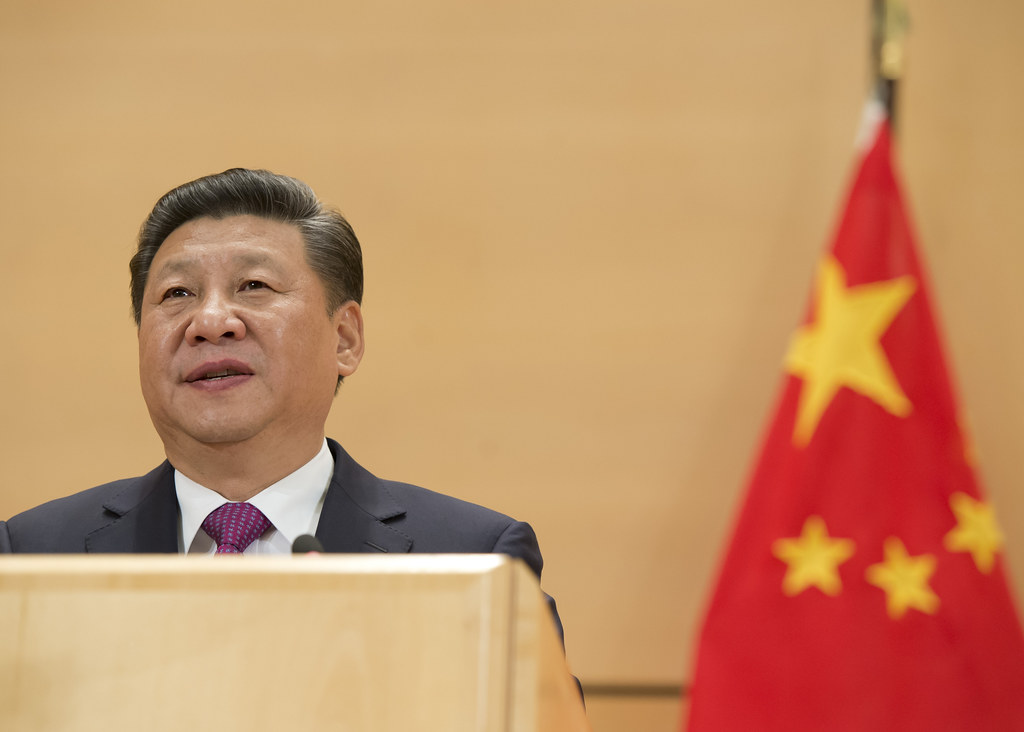 Far from siding with the Myanmar masses, the Chinese regime wants stability to continue doing business with its neighbour / Image: UN, Flickr
Far from siding with the Myanmar masses, the Chinese regime wants stability to continue doing business with its neighbour / Image: UN, Flickr
The Chinese regime fears any successful movement in Myanmar that could overthrow the regime from below, as it would be a very bad precedent for itself. What the Chinese regime is concerned about more than anything else is stability within its sphere of influence. It wants an environment that can guarantee good economic relations. They have no particular problem with either ASSK or the military. Indeed, ASSK herself acknowledged the power of China when she was in office, making several official trips to Beijing. The main question of concern for the Chinese regime is: can the military guarantee stability?
If the situation in Myanmar spirals out of control, then it will be Beijing that will push the Myanmar military into some kind of compromise with the NLD politicians. It has done this before. Back in 2007 China urged the military to open up discussions with Aung San Suu Kyi, who was then under house arrest, because the pressure from below threatened to unleash a movement of revolutionary proportions.
Other regimes in the region are already pushing this line. Indonesia is promoting the idea of “negotiations” between the military and the NLD. Indonesia has called on the military to guarantee “fair elections”, ignoring the fact that the masses reject this very idea. Indonesia is de facto recognising the military junta as the legitimate government at this moment in time, precisely when the masses are calling for an “end to 2008”, which means an end to the present constitution and the special powers it grants the army.
In the present situation, a demand that would mobilise the whole people would be the call for a genuinely democratic parliament. That would mean the convening of a Revolutionary Democratic Constituent Assembly with no guarantees, quota of MPs, or special powers for the military. This would be the very minimum of democratic demands that would meet the aspirations of the Myanmar masses today.
As we have seen, the NLD has not been prepared to adopt such demands, but has tried to compromise with the military and seek small, gradual changes, fearing to upset the powerful military oligarchs. And we have seen where that has led. By leaving intact the power of the military, the latter have been left with the apparatus with which to take back control of government.
Myanmar is a country where the old Communist Party has left a strong Stalinist tradition. An essential part of Stalinist thinking is that a country like Myanmar is not ripe for socialism,that it is not developed enough to allow for an independent movement of the working class, and therefore support for the so-called “progressive bourgeoisie” is an essential part of their thinking.
It is true that much of Myanmar is rural and peasant. It still has a relatively undeveloped agriculture, which provides 24 percent of GDP but employs 70 percent of the overall workforce. However, there is also a strong working class. The garment workers alone number 700,000. There are major cities like Yangon with its more than five million inhabitants, or Mandalay with one and a half million. The overall urban population is 31 percent of the total. Industrial production provides 35 percent of GDP, with services providing 40 percent.
When we look at Myanmar today, we find a far more developed economy than Russia in 1917. And what we see in the present movement is that urban, modern Myanmar is leading the way. The movement started with workers in the industrial areas and spread to other sectors. The working class could play the same role in Myanmar today as it did in Russia in 1917.
What is missing in Myanmar today is not a working class. What is missing is a party like the Bolshevik Party, which would be capable of uniting the working class around a programme for the revolutionary overthrow not only of the present military junta, but of the whole rotten system. Such a party needs to be built and the first step towards such a party is the building of a Marxist tendency embedded among the youth and the workers of Myanmar.
